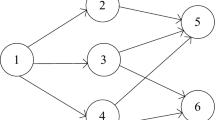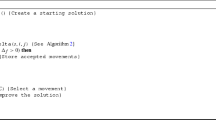Abstract
Determining the sequence of a long DNA chain first requires dividing it into subset fragments. The DNA fragment assembly (DFA) approach is then used for reassembling the fragments as an NP-hard problem that is the focus of increasing attention from combinatorial optimization researchers within the computational biology community. Particle swarm optimization (PSO) is one of the most important swarm intelligence meta-heuristic optimization techniques to solve NP-hard combinatorial optimization problems. This paper proposes a memetic PSO algorithm based on two initialization operators and the local search operator for solving the DFA problem by following the overlap–layout–consensus model to maximize the overlapping score measurement. The results, based on 19 coverage DNA fragment datasets, indicate that the PSO algorithm combining tabu search and simulated annealing-based variable neighborhood search local search can achieve the best overlap scores.





Similar content being viewed by others
Explore related subjects
Discover the latest articles, news and stories from top researchers in related subjects.References
Wang R-Y, Shi Z-Y, Guo Y-Y, Chen J-C, Chen G-Q (2013) DNA fragments assembly based on nicking enzyme system. PLoS One 8(3):e57943
Zhang Y, Fu B, Zhang X (2012) Dna cryptography based on DNA fragment assembly. In: Information science and digital content technology (ICIDT), 2012 8th international conference on, vol 1, pp 179–182
Staden R (1980) A new computer method for the storage and manipulation of DNA gel reading data. Nucleic Acids Res 8(16):3673–3694
Sanger F, Coulson AR, Hong GF, Hill DF, Petersen GB (1982) Nucleotide sequence of bacteriophage lambda DNA. J Mol Biol 162(4):729–73
Hassanien AE, Al-Shammari ET, Ghali NI (2013) Computational intelligence techniques in bioinformatics. Comput Biol Chem 47:37–47
Sutton GG, White O, Adams MD, Kerlavage AR (1995) Tigr assembler: a new tool for assembling large shotgun sequencing projects. Genome Sci Technol 1(1):9–19
Green P (1994) PHRAP. http://www.phrap.org
Huang X, Madan A (1999) Cap3: a DNA sequence assembly program. Genome Res 9(9):868–877
Chen T, Skiena SS (2000) A case study in genome-level fragment assembly. Bioinformatics 16:494–500
Bonfield JK, Smith KF, Staden R (1995) A new DNA sequence assembly program. Nucleic Acids Res 23:4992–4999
Myers EW (2000) A whole-genome assembly of drosophila, pp 2196–2204
Batzoglou S, Jaffe DB, Stanley K, Butler J, Gnerre S, Mauceli E, Berger B, Mesirov JP, Lander ES (2002) Arachne: a whole-genome shotgun assembler. Genome Res 12(1):177–189
Bocicor M, Czibula G, Czibula I (2011) A reinforcement learning approach for solving the fragment assembly problem. In: Symbolic and numeric algorithms for scientific computing (SYNASC), 2011 13th international symposium on, pp 191–198
Chang Y, Sahinidis NV (2011) An integer programming approach to DNA sequence assembly. Comput Biol Chem 35(4):251–258
Caserta M, Vo S (2014) A hybrid algorithm for the DNA sequencing problem. Discrete Appl Math 163 Part 1(0):87–99
Pevzner PA (2000) Computational molecular biology—an algorithmic approach. MIT Press, Cambridge, MA
Schmitt KRB, Zimin AV, Marcaçs G, Yorke JA, Girvan M (2013) A hierarchical network heuristic for solving the orientation problem in genome assembly. ArXiv e-prints
Burks C, Engle M, Forrest S, Parsons R, Soderlund C, Stolorz P (1994) Stochastic optimization tools for genomic sequence assembly. Automated DNA sequencing and analysis. Academic Press, London
Alba E, Luque G, Khuri S (2005) Assembling DNA fragments with parallel algorithms. In: IEEE congress on evolutionary computation, vol 1, pp 57–64
Baewicz J, Formanowicz P, Kasprzak M, Markiewicz WT, Wglarz J (2000) Tabu search for DNA sequencing with false negatives and false positives. Euro J Oper Res 125(2):257–265
Parsons RJ, Forrest S, Burks C (1995) Genetic algorithms, operators, and DNA fragment assembly. Mach Learn 21(1–2):11–33
Fang SC, Wang Y, Zhong J (2005) A genetic algorithm approach to solving DNA fragment assembly problem. J Comput Theor Nanosci 2:499–505
Kikuchi S, Chakraborty G (2006) Heuristically tuned GA to solve genome fragment assembly problem. In: IEEE congress on evolutionary computation, pp 1491–1498
Alba E, Luque G (2008) A hybrid genetic algorithm for the dna fragment assembly problem. In: Recent advances in evolutionary computation for combinatorial optimization, pp 101–112
Minetti G, Alba E, Luque G (2008) Seeding strategies and recombination operators for solving the DNA fragment assembly problem. Inf Process Lett 108(3):94–100
Luque G, Alba E (2011) Parallel gas in bioinformatics: assembling DNA fragments. Stud Comput Intell 367(9):135–147
Meksangsouy P, Chaiyaratana N (2003) DNA fragment assembly using an ant colony system algorithm. In: The congress on evolutionary computation, vol 3, 1756–1763
Wetcharaporn W, Chaiyaratana N, Tongsima S (2006) DNA fragment assembly by ant colony and nearest neighbour heuristics. In: Proceedings 8th international conference artificial intelligence and soft computing, vol 4029
Ibrahim Z, Kurniawan TB (2009) Implementation of an ant colony system for DNA sequence optimization. J Artif Life Robot 293–296
Firoz JS, Rahman MS, Saha TK (2012) Bee algorithms for solving DNA fragment assembly problem with noisy and noiseless data. In: Proceedings of the fourteenth international conference on genetic and evolutionary computation conference, pp 201–208
Nazri MZA, Huri MD, Bakar AA, Abdullah S, Dan AM, Kurniawan TB (2013) DNA sequence design using artificial immune systems. J Eng Appl Sci 8(2):49–57
Dorronsoro B, Bouvry P, Alba E (2010) Iterated local search for de novo genomic sequencing. In: Rutkowski L, Scherer R, Tadeusiewicz R, Zadeh L, Zurada JM (eds) Artificial intelligence and soft computing, volume 6114 of lecture notes in computer science. Springer, Berlin, pp 428–436
Kubalik J, Buryan P, Wagner L (2010) Solving the DNA fragment assembly problem efficiently using iterative optimization with evolved hypermutations. In: Proceedings of the 12th annual conference on genetic and evolutionary computation, GECCO ’10, pp 213–214
Kato T, Hasegawa M (2011) Performance of heuristic methods driven by chaotic dynamics for ATSP and applications to DNA fragment assembly. Nonlinear Theory Appl IEICE 2(4):485–496
Luque G, Dorronsoro B, Alba E, Bouvry P (2008) A self-adaptive cellular memetic algorithm for the DNA fragment assembly problem. In: IEEE congress on evolutionary computation, pp 2651–2658
Minetti G, Luque G, Alba E (2008) Variable neighborhood search as genetic algorithm operator for DNA fragment assembling problem. In: Eighth international conference on hybrid intelligent systems, pp 714–719
Nemati S, Basiri ME, Ghasem-Aghaee N, Aghdam MH (2009) A novel acoga hybrid algorithm for feature selection in protein function prediction. Expert Syst Appl 36(10):12086–12094
Minetti G, Leguizamon G, Alba E (2012) Sax: a new and efficient assembler for solving DNA fragment assembly problem. In: 13th Argentine symposium on artificial intelligence
Minetti G, Leguizamn G, Alba E (2014) An improved trajectory-based hybrid metaheuristic applied to the noisy DNA fragment assembly problem. Inf Sci 277:273–283
Nebro AJ, Luque G, Luna F, Alba E (2008) DNA fragment assembly using a grid-based genetic algorithm. Comput Oper Res 35(9):2776–2790
Verma RS, Singh V, Kumar S (2011) Article: DNA sequence assembly using particle swarm optimization. Int J Comput Appl 28(10):33–38
Huang K-W, Chen J-L, Yang C-S (2012) A hybrid PSO-based algorithm for solving DNA fragment assembly problem. In: Third international conference on innovations in bio-inspired computing and applications, pp 223–228
Firoz JS, Rahman MS, Saha TK (2012) Hybrid meta-heuristics for DNA fragment assembly problem for noiseless data. In: Informatics, electronics vision (ICIEV), 2012 international conference on, pp 652–656
Mallen-Fullerton GM, Fernandez-Anaya G (2013) DNA fragment assembly using optimization. In: Evolutionary computation (CEC), 2013 IEEE congress on, pp 1570–1577
Compeau PEC, Pevzner PA, Tesler G (2011) How to apply de bruijn graphs to genome assembly. Nat Biotechnol 29(11):987–991
Miller JR, Koren S, Sutton G (2010) Assembly algorithms for next-generation sequencing data. Genomics 95(6):315–327
Li Z, Chen Y, Mu D, Yuan J, Shi Y, Zhang H, Gan J, Li N, Xuesong H, Liu B et al (2012) Comparison of the two major classes of assembly algorithms: overlap–layout–consensus and de-bruijn-graph. Brief Funct Genomics 11(1):25–37
Pevzner PA, Tang H, Waterman MS (2001) An Eulerian path approach to DNA fragment assembly. Proc Natl Acad Sci 98(17):9748–53
Simpson J, Wong K, Jackman S, Schein J, Jones S, Birol I (2009) Abyss: a parallel assembler for short read sequence data. Genome Res 19:1117
Xu B, Gao J, Li C (2012) An efficient algorithm for DNA fragment assembly in mapreduce. Biochem Biophys Res Commun 426(3):395–398
Couto AD, Cerqueira FR, Guerra RL, Goncalves LB, Goulart CDC, Siqueira-Batista R, Ferreira RDS, Oliveira ADP (2012) Theoretical basis of a new method for DNA fragment assembly in k-mer graphs. In: Chilean computer science society (SCCC), 2012 31st international conference of the, pp 69–77
Gritsenko AA, Nijkamp JF, Reinders MJT, de Ridder D (2012) Grass: a generic algorithm for scaffolding next-generation sequencing assemblies. Bioinformatics 28(11):1429–1437
Hassan H, Majid ZA, Halim AK, Ibrahim A (2013) Design and development of DNA fragment assembly using IWP method. In: Control and system graduate research colloquium (ICSGRC), 2013 IEEE 4th, pp 63–68
Glover F, Laguna M (1997) Tabu Search. Kluwer, Norwell, MA
Kirkpatrick S, Gelatt CD, Vecchi MP (1983) Optimization by simulated annealing. Science 220:671–680
Mladenovic N (1997) Variable neighborhood search. Comput Oper Res 24(11):1097–1100
Swarnkar R, Tiwari MK (2004) Modeling machine loading problem of FMSs and its solution methodology using a hybrid tabu search and simulated annealing-based heuristic approach. Robot Comput Integr Manuf 20(3):199–209
Metropolis N, Rosenbluth AW, Rosenbluth MN, Teller AH, Teller E (1953) Equation of state calculations by fast computing machines. J Chem Phys 21(6):1087–1092
Bandyopadhyay S, Saha S, Maulik U, Deb K (2008) A simulated annealing-based multiobjective optimization algorithm: AMOSA. IEEE Trans Evol Comput 12(3):269–283
Liu B, Wang L, Jin Y-H (2007) An effective PSO-based memetic algorithm for flow shop scheduling. IEEE Trans Syst Man Cybern Part B Cybern 37(1):18–27
Tasgetiren MF, Liang Y-C, Sevkli M, Gencyilmaz G (2007) A particle swarm optimization algorithm for makespan and total flowtime minimization in the permutation flowshop sequencing problem. Eur J Oper Res 177(3):1930–1947
Gendreau M, Potvin J-Y (2010) Handbook of metaheuristics, 2nd edn. Springer Publishing Company, Berlin
Kennedy J, Eberhart R (1995) Particle swarm optimization. In: IEEE international conference on neural networks, vol 4, pp 1942–1948
Kennedy J, Eberhart RC (1997) A discrete binary version of the particle swarm algorithm. In: IEEE international conference on systems, man, and cybernetics, vol 5, pp 4104–4108
Shi Y, Eberhart R (1998) A modified particle swarm optimizer. In: Proceedings of IEEE international conference on evolutionary computation, pp 69–73
Coull SE, Szymanski BK (2008) Sequence alignment for masquerade detection. Comput Stat Data Anal 52(8):4116–4131
Bean JC (1994) Genetic algorithms and random keys for sequencing and optimization. ORSA J Comput 6(2):154–160
Onwubolu GC, Davendra D (2009) Differential evolution: a handbook for global permutation-based combinatorial optimization. Springer Publishing Company, Berlin
Engle ML, Burks C (1993) Artificially generated data sets for testing DNA sequence assembly algorithms. Genomics 16(1):286–288
Yang C-S, Chuang L-Y, Ke C-H, Yang C-S (2008) Comparative particle swarm optimization (CPSO) for solving optimization problems. In: Research, innovation and vision for the future, 2008. RIVF 2008. IEEE international conference on, pp 86–90
Rashedi E, Nezamabadi-Pour H, Saryazdi S (2009) GSA: a gravitational search algorithm. Inf Sci 179(13):2232–2248
Derrac J, Garca S, Molina D, Herrera F (2011) A practical tutorial on the use of nonparametric statistical tests as a methodology for comparing evolutionary and swarm intelligence algorithms. Swarm Evol Comput 1:3–18
Zhu Z, Zhou J, Ji Z, Shi Y (2011) DNA sequence compression using adaptive particle swarm optimization-based memetic algorithm. IEEE Trans Evol Comput 15(5):643–658
Zhan Z-H, Zhang J, Li Y, Shi Y (2011) Orthogonal learning particle swarm optimization. IEEE Trans Evol Comput 15(6):832–847
Senthilnath J, Omkar SN, Mani V (2011) Clustering using firefly algorithm: performance study. Swarm Evol Comput 1(3):164–171
Acknowledgments
The authors would like to thank the editors and anonymous reviewers for their valuable comments and suggestions on the paper that greatly improve the quality of the paper. This work was supported in part by the National Science Council, Taiwan, R.O.C., under Grants NSC 102-2219-E-006-001-, NSC 100-2218-E-006-MY3 and NSC 102-2221-E-041-006.
Author information
Authors and Affiliations
Corresponding author
Rights and permissions
About this article
Cite this article
Huang, KW., Chen, JL., Yang, CS. et al. A memetic particle swarm optimization algorithm for solving the DNA fragment assembly problem. Neural Comput & Applic 26, 495–506 (2015). https://doi.org/10.1007/s00521-014-1659-0
Received:
Accepted:
Published:
Issue Date:
DOI: https://doi.org/10.1007/s00521-014-1659-0




